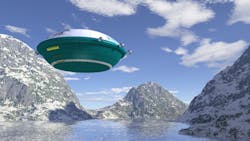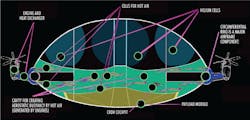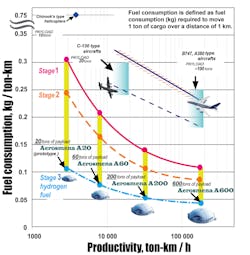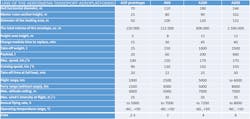Innovative Airships Could Change the Face of Transport Aircraft
While some aerospace engineers are working on sexy, attention-getting aircraft such a supersonic airliners and Mach 3+ jet fighters, others are focused on the seemingly more mundane but more useful goal of developing innovative heavy-lift cargo aircraft. One such team of designers at the Airship Initiative Design Bureau Aerosmena (AIBDA) in Russia are working on a lighter-than-air hybrid that could expand the scope of aviation and cargo transport.
Their approach combines helium and hot air for lift, along with turboprop jet engines turning helicopter-like rotors for propulsion, thrust-vectoring, control, and some additional lift. The Russian-based team, led by CEO Sergei Bendin, plans on turning out a family of four such airships that can carry anywhere from 22 to 660 tons up to 3,700 miles.
Basic Design
The AIDBA concept consists of two modules: the flight module (FM), which is a piloted airship, and mission-specific payload modules (PM). The FM contains the lift and propulsion subsystems and acts as the aircraft’s “locomotive.” Each FM can carry a PM clipped and clamped onto the rigid internal cross-truss structure on its underside. Attaching a PM to the FM takes about 15 min. for the smaller airships and 45 min. for large ones, based on preliminary designs.
The designers envision a range of PMs tailored to the mission at hand. They could carry strictly cargo, passengers, or a mix of both. PMs could also be outfitted as firefighters, mobile hospitals or repair facilities, luxury “yachts,” sightseeing vehicles, and military drone carriers. And when they are brought to market, a host of other types of PMs will also likely be built as well.
For bulky and oversized cargo too large for other PMs, such as an entire building or drilling rig, a PM could be equipped with winches and cables to pick up and deliver the payload on a sling hanging below the airship. This eliminates the need for any landing field and will let the airships service remote, forested areas or crowded cities, as well as stationary and underway ships at sea.
The FM airframe resembles a bicycle wheel with a rim (the ring), a wheel hub (the internal central support column) and spokes (the eight support trusses). Some of these structures will be made of strong but lightweight alloys and carbon-fiber composites. The designers also plan on using lightweight foamed metals for thermal protection on some components.
The ring supports the heavy equipment, such as the turboprop engines and heat exchangers. It also works with the trusses to support the durable, semi-rigid upper cupola and hull cover. The cover protects the airship’s internal workings from the environment and gives the hull an aerodynamic shape that generates lift when moving through the air. The design lets the airships fly at up to 130 mph, though they might initially be limited to lower speeds.
The trusses form eight sections inside the airship, each with two cells—an upper one for helium and a lower one for hot air.
Pressure in the helium cells is about 0.3% to 0.5% above atmospheric pressure. All the airship’s helium is in these eight cells and provides enough lift to support all but about 5 to10% of the FM’s weight. But when combined with the lift from the rotors, it can fly with no hot air onboard if there is no PM.
Helium molecules are small, so leaks are inevitable from the helium cells. But the helium cells will be lined with several layers of high-tech polymer films to reduce losses. Bendin is confident those films will keep losses on the small A20 airship with a 230-ft diameter hull to about 106,000 ft3 per day or 1.2% of its total helium; the larger A600 with its 810-ft diameter hull will lose 177,000 ft3 per day or 0.8% of its helium.
The airships carry no extra helium or ballast (sand or water) that can be released to increase lift. Instead, they rely on controlling the temperature and amount of hot air in the upper cells to adjust altitude and lifting capabilities, a concept called thermal ballasting. They can also enlist their engines and rotors to supply lift (or a downward thrust) for altitude adjustments.
The inside of the hot-air cells will be lined with a heat-resistant material such as lightweight glass wool, which withstands long-term exposure to temperatures up to 570°F.
The hot air comes from heat exchangers that take heat from the jet engines’ exhaust to bring incoming fresh air up to anywhere from 390°F to 480°F. Some of that air gets channeled inside of the upper hull to heat the helium to increase its buoyancy, remove snow from the airship’s upper surface, and prevent ice from forming when in flight.
With no hot air onboard, the airships can be parked on the ground without being tied down at wind speeds up to 55 mph. At higher wind speeds, the airships can be tethered to the ground, or the vectoring rotors can generate a stabilizing downforce. No hangar is needed; the semi-rigid covering supported by the internal structure protects the airship from weather.
Unlike traditional blimps and dirigibles, the AIBDA airship requires no mooring equipment, large landing sites, or large ground crews. They have landing gear and can operate from small undeveloped fields, such as remote construction sites. They can also land on water, but that would be an emergency procedure as the design team has yet to devise a method for the FM or a PM to handle taking off from the water.
Because the airships need hot air for lift when carrying out missions, they need about 45 min. to fill the hot-air cells before lifting any payloads.
Power and Controls
Turboshaft engines and large variable-speed, reversible rotors will be mounted on pylons evenly spaced around the ring, with the smaller airships carrying four and the larger ones carrying eight.
The current plan is to repurpose engines from military helicopters. The design team is looking at using 11,400-hp ZMKB Progress D-136 engines, which power Russia’s Mi-26 HALO heavy transport helicopter, and 2,400-hp Klimov VK 2500 engines used on the Hokum A attack helicopter.
The A20, the smallest airship, will carry up to 24,000 lb of aviation fuel which would let it fly nonstop for 1,900 miles; the A600, the largest airship, will carry 70,000 lb of fuel, giving it a non-stop range of 3,100 miles.
An Aboard Smart Control System (ASCS) coordinates operation of each thrust vectoring rotor and engine, as well as buoyancy throughout the flight envelope (including takeoffs and landings), when hovering and when taking on or delivering payloads.
The AIDBA Airship Fleet
The A20 will be the prototype for the entire Aerosmena family, and then become the smallest airship in the fleet. It will be 230 ft in diameter and carry 20-metric tons (22-tons) with a three-person crew. It will be able to carry a PM for up to 100 passengers, with each enjoying much more space than available on commercial airliners and trains. For long flights, passengers will have access to sleeping quarters, in-flight food and entertainment, and individual rescue devices. The A20 will also be able to carry PMs designed as medical clinics, cargo containers and even a flying observatory/lounge-that give fans, observers and VIPs panoramic views of parades or military and civil events.
The A60, planned as short-haul transport airship, will have a 361-ft diameter and carry up to a 60-metric ton (66-ton) payload. It can land in flat, round areas 394 ft in diameter (just a bit bigger than the airship itself). AIDBA expects the cost for the A60 project, from development to certification, to be about $120 million. Its PMs can be set up as a mobile hospital or repair shop for heavy equipment, a firefighter, a luxury hotel/corporate or a private yacht, and carry passengers or cargo containers.
The A200 medium-range transport airship has a (591-ft diameter and can carry a 200-metric ton (220-ton) payload. It could be used for many of the same missions as the A60, but on a larger scale. The design team believes the A60 and A200 will be well-suited for battling fires. An A200, for example, should be able to fill on-board tanks with water from any natural or artificial basin while hovering in about 40 min. If conditions over the fire permit, the water can be accurately dumped while hovering. Or the water can be delivered with more accuracy using water cannons to direct the spray. AIDBA expects the cost for the A200, from development to certification, to be about $150 million.
The A600 long-range heavy transport is the largest airship. It will stand about 165 ft high and have a diameter of 807 ft. For comparison, the Superdome in New Orleans measures “only” 680 ft in diameter. The A600 has a total envelope volume of 88.2 million ft3, more than 12 times the volume of the Hindenburg. It is designed to carry a 600-metric ton (660-ton) payload. The A600 will be able to accommodate a PM configured for 2,000 people in the same roomy comfort as the A20. It will have a crew of six, though it would also likely carry a dozen or more flight attendants when carrying a full load of passengers.
The A600’s size and lift capability will let it carry out a host of missions, including serving as an aircraft or drone carrier, launching rockets or spacecraft, and transporting large military units, complete with vehicles and supplies.
AIDBA expects the cost for the A600 project, from development to certification, to be about $480 million. The cost of manufacturing one airship would be to about $93 million, but if several were made, costs would fall to around $70 million apiece.
In 2020, AIDBA announced plans to launch its A600 airship program in 2024. However, the pandemic and its effect on the global economy weakened the potential market for the A600. Consequently, the launching was postponed.







